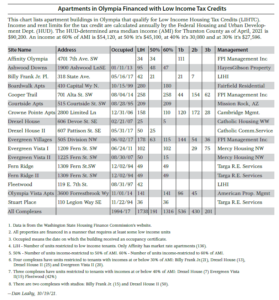The limits of a federal tax credit program as a way to produce stable housing for low income households
I’ve spent the last few years writing about the City of Olympia’s relentless push to construct market rate, luxury apartments in the downtown core. This policy of increasing the equity ownership of developers like Walker John continues. If you add Walker John’s four new projects to Ronald Newman’s West Bay Yards, this makes 675 more market rate luxury units, unaffordable to the 47% of Olympians who are low income.
Are there any low income housing complexes in Olympia? Where are they, how much do they charge and are there any projects under construction? The Housing Authority of Thurston County (HATC) has five low income complexes in Olympia with 204 units, but the biggest source of low income housing is financed primarily through the Low Income Housing Tax Credit (LIHTC) program.
A federal tax incentive for private investors
The LIHTC mechanism was created by the 1986 Reagan Tax Reform Act. It creates low income housing by combining a “Managing Partner” with an “Investor Partner.” The Managing Partner is usually a 501c3 Tax Exempt Non Profit organization, like the Low Income Housing Institute (LIHI) or Mercy Housing. An “Investor Partner” is a corporation or bank that wants to reduce what it pays in taxes via a tax credit for 10 years. The Investor Partner gets his tax credit in exchange for investing in an income and rent restricted housing project that will be rented to low income tenants.
In the midst of our housing crisis, why have there been no significant LIHTC projects in Olympia since 2017?
The tax credit program represents the country’s largest source of financing for low income housing and has made possible an estimated 3 million housing units since 1986. This program has cost the federal government an average of $8 billion each year in lost revenue, according to the Tax Foundation. Here in Washington State, it generated 103,000 units in the 33 years from 1986 to 2019. However, this financing source can be fairly unpredictable depending upon corporate income and federal tax policy.
What those incentives have produced in Olympia
There are seventeen LIHTC apartment complexes with an Olympia address. They have 1,738 units that are rent- and income-restricted. The earliest of these, Stuart Place in downtown Olympia, was built in November 1994. This was followed by the Fern Ridge apartments in December 1994, the Courtside Apartments in 1995, the Fleetwood in 1997 and the Boardwalk (senior only) apartments in 1999. The remaining complexes were all built four years ago in 2017: the Billy Frank, Jr. and Drexel House II –with the majority of their units for the homeless –and an expansion of the Evergreen Villages on Division Street NW.
Income levels and maximum rents in these complexes are set according to the Area Median Income (AMI). The Federal Housing and Development Department (HUD) determines each county’s AMI. As of April 2021, Thurston County’s AMI was $90,200 for a family of four. The income limit for the vast majority of LIHTC apartments in Olympia, 1,316 units, is set at 60% of AMI. Rents vary depending on unit size. A studio rent is $948, a one bedroom is $1,015; a two-bedroom is $1,218 and a 3-bedroom is $1,407. Importantly, these rents can be lower if the project or the tenant has a HUD voucher. or if the owner chooses to set rents lower than the maximum allowable.
A shift away from low income to market rate housing
The question is, in the midst of our housing crisis, why have there been no significant LIHTC projects in Olympia since 2017? Beginning with the 2007-2008 financial collapse, LIHTC financing slowed down and has declined ever since. In addition, the Trump 2017 Tax Cut Act (TCJA) slashed the corporate tax rate to 21% thus decreasing the incentive for corporations to purchase LIHTC tax credits.
The City of Olympia has focused primarily on granting 8-year property tax exemptions for the construction of high-end luxury units affordable only to high-income households. This has supported construction of 549 units since 2015, with a tax gift to developers amounting to $10 million dollars over the eight years. The City has authorized an additional 675 luxury units, a total of 1,224. In contrast to the City’s prioritization of market rate units, the Low Income Housing Institute (LIHI) and the Family Support Center have sought to use the tax credits to build low-income units, 62 units at 2828 Martin Way and 62 units on 7th Avenue SW, respectively.
Lower rents in LIHTC-financed projects aren’t permanent
There’s another difficulty with the LIHTC mechanism. This financing mechanism does not necessarily produce permanent low income housing. Typically, after 15 years, the non-profit partner uses their “right of first refusal” to gain full project ownership while still allowing the investor to make use of the tax credit for an additional 15 years.
This transfer of ownership ensures the project will remain a low income housing project for the foreseeable future. However, with the rise in real estate values, there is a financial incentive for investors, known as aggregators, to challenge the non-profit partner for direct ownership of the property and begin charging market rate prices. There are four separate lawsuits in Washington federal district courts attempting to do just this.
City Council members talk about equity in housing, Their policies have led to a massive growth of inequity in housing. They’ve promoted 1,224 units of luxury apartments and only 124 units of low income housing. They must change course if enough low income housing will be built to meet the community’s need. Instead of subsidizing Walker John or Ronald Newman, they could be working with the Housing Authority of Thurston County, the only source of permanent low-income housing in the City.
Dan Leahy taught public policy analysis at The Evergreen State College MPA program for six years. He retired in 2008 and lives on Olympia’s Westside.


Be First to Comment